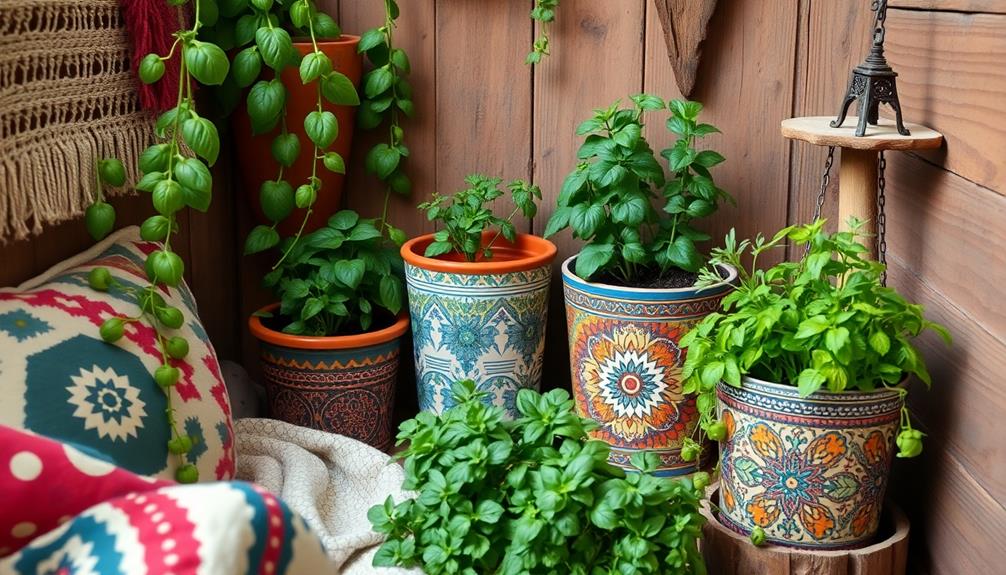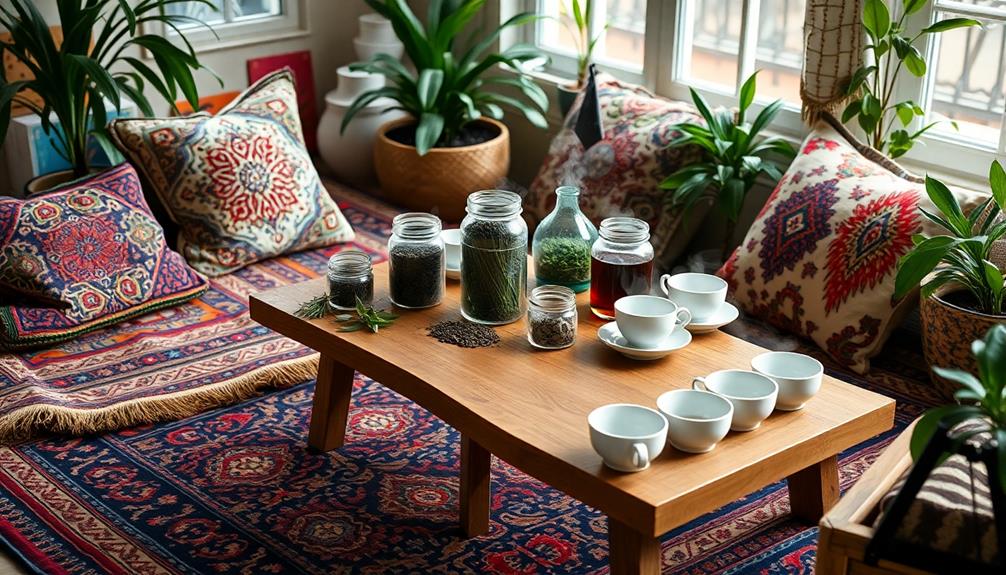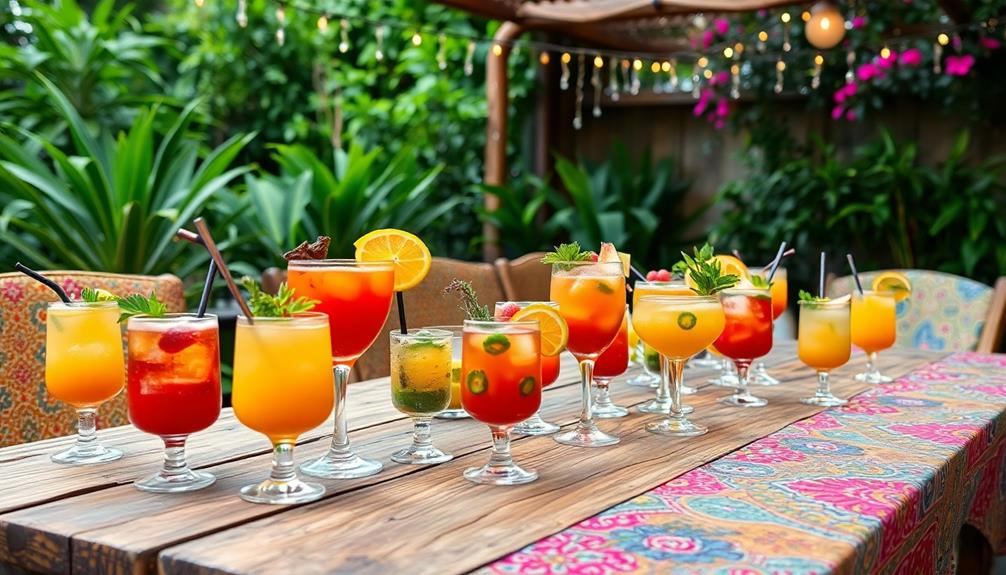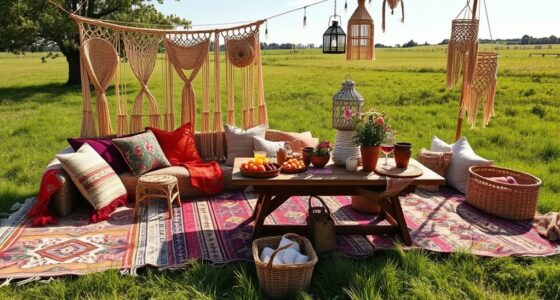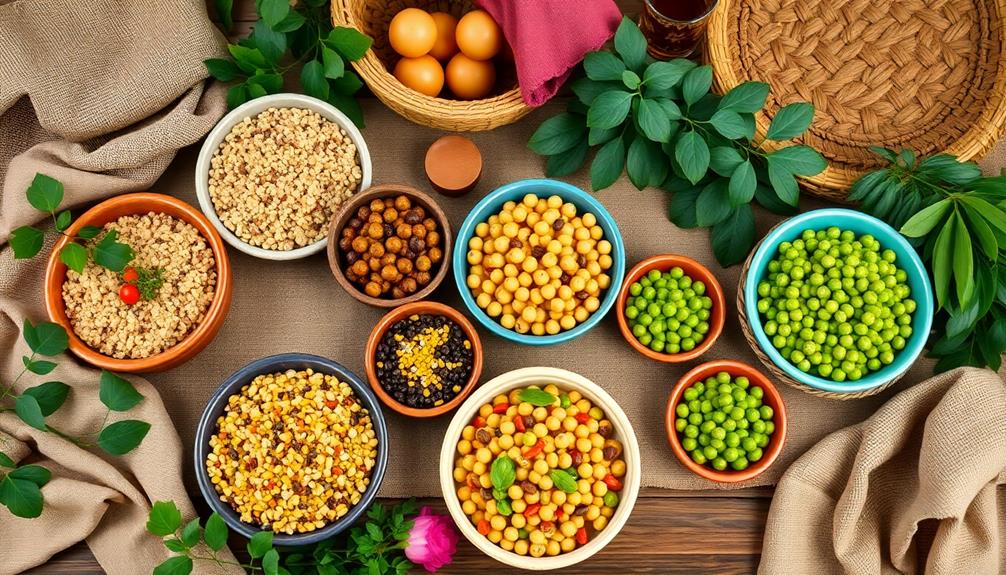You can easily transform a small space into a vibrant Boho herb garden that brings both beauty and functionality to your home. Start by selecting colorful or rustic containers, ensuring they have proper drainage. Choose low-maintenance herbs like basil, mint, and thyme, and arrange them based on their water needs for ideal growth. Mix heights with hanging planters or wall-mounted options to maximize your area. Incorporate whimsical elements, like vintage teacups, for a unique touch. Regular maintenance and creative arrangements will keep your garden thriving and colorful, and there's plenty more to explore as you create your personal oasis.
Key Takeaways
- Choose visually appealing containers, like colorful ceramics or rustic wooden boxes, ensuring they have proper drainage for healthy herb growth.
- Group herbs based on their water needs to optimize space and promote healthy growth, placing moisture-lovers centrally.
- Incorporate vertical gardening techniques using wall-mounted planters or hanging baskets to maximize limited space effectively.
- Utilize upcycled materials, like old teacups or painted tins, to add a whimsical touch and enhance the garden's boho aesthetic.
- Regularly prune and harvest herbs to encourage bushier growth and maintain vitality in your small garden.
Benefits of a Boho Herb Garden
Creating a Boho herb garden offers numerous benefits that go beyond just aesthetics. By combining diverse and colorful planters with rustic materials, you can create a unique space that reflects your personal style. This vibrant arrangement not only enhances visual interest but also transforms your small space, like a balcony or patio, into a relaxing oasis.
Incorporating fresh herbs such as basil, mint, and rosemary adds both beauty and functionality to your garden, and certain herbs like rosemary may even support neuroprotection, offering tea varieties shielding minds from dementia's grip. You'll enjoy having fresh ingredients right at your fingertips, elevating your meals with vibrant flavors and delightful aromas. Plus, a Boho herb garden encourages creativity, allowing you to mix and match elements that resonate with you.
Another advantage is that you can utilize upcycled materials, like repurposed containers, making your garden budget-friendly and environmentally sustainable. The therapeutic benefits of gardening also come into play; tending to your plants can relieve stress and improve your mental well-being.
This connection with nature becomes even more significant in small urban spaces, making a Boho herb garden not just a visual delight but a sanctuary for the mind and spirit.
Selecting the Right Containers
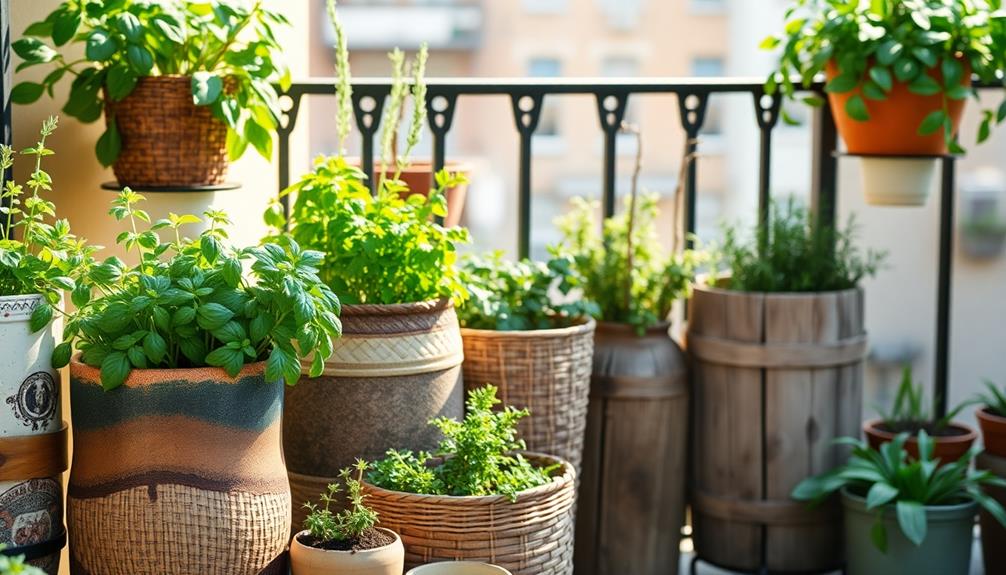
To bring your Boho herb garden to life, selecting the right containers is key. You'll want to choose herb planters that not only look great but also serve a practical purpose.
Here are some tips to help you pick the perfect containers:
- Size Matters: Aim for containers that are at least 6-12 inches deep and 12 inches wide. This gives your herbs the space they need to grow and allows for multiple plants in one container.
- Material Choice: Opt for visually appealing materials like galvanized steel, colorful ceramics, or even repurposed items. Think painted tins or wooden boxes that align with your boho aesthetic while being functional.
- Drainage is Essential: Confirm all your containers have proper drainage holes. This prevents over-watering, which is vital for keeping your herbs healthy and thriving.
Mixing various container sizes and shapes adds visual interest to your garden.
Don't forget to take into account hanging planters or wall-mounted options to maximize vertical space, making your herb garden both whimsical and practical.
Preparing Your Containers
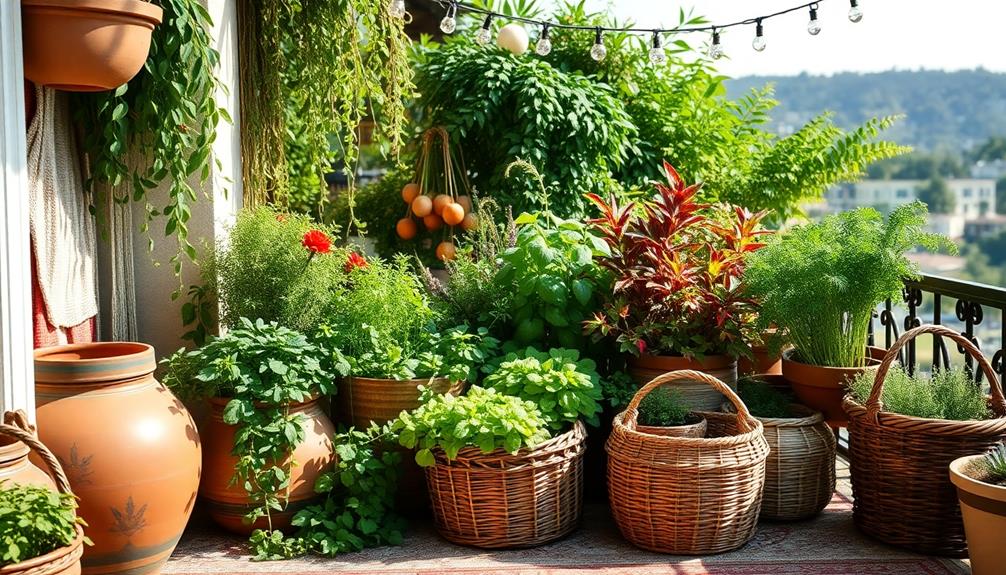
Before planting your herbs, it's vital to prepare your containers properly. Choose containers that are 6-12 inches deep and at least 12 inches wide. This size accommodates the shallow root systems of most herbs, ensuring they've enough space to thrive.
To enhance the boho aesthetic, opt for visually appealing materials like colorful ceramic, upcycled tea tins, or rustic wooden boxes.
Next, make sure each container has drainage holes spaced every 3-4 inches. This step is important to prevent waterlogging, which can harm the herb roots and hinder their growth.
Fill your containers with a well-draining soil mix that includes topsoil, compost, and coarse sand. This combination promotes drainage and helps retain the nutrients your herbs need to flourish.
Choosing Herbs for Small Spaces
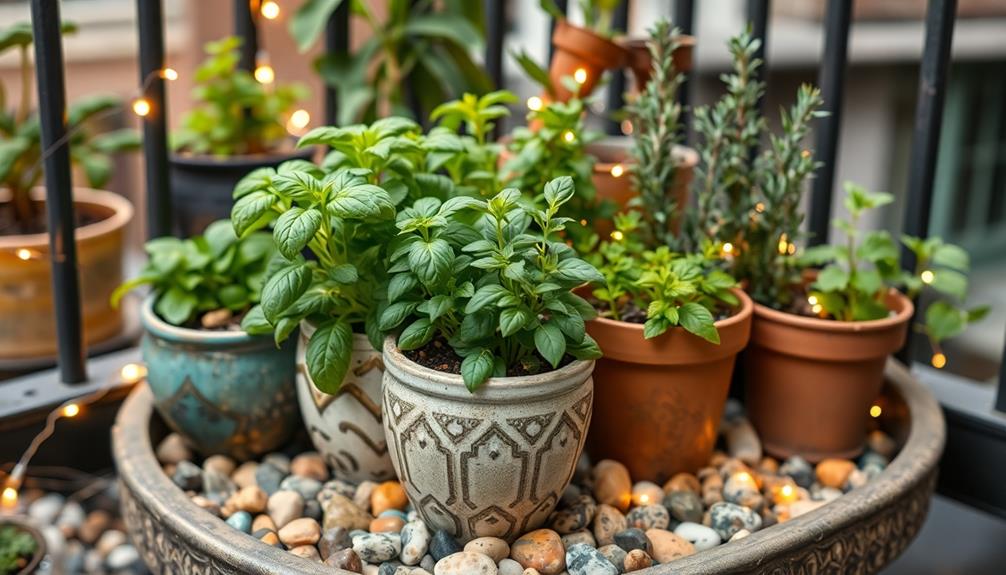
When you're choosing herbs for small spaces, focus on low-maintenance varieties like chives, basil, and thyme that thrive in containers.
It's smart to group your herbs based on their water needs; for example, keep moisture-loving parsley near the center and drought-tolerant rosemary at the edges.
This way, you'll create a thriving, organized garden that looks great and is easy to care for.
Best Herbs for Containers
Creating a thriving herb garden in containers not only maximizes your limited space but also adds vibrant flavors to your cooking. When you choose the right herbs, you'll find that even a small pot can yield abundant growth.
Consider these low-maintenance varieties that thrive in shallow pots:
- Chives – These herbs are hardy, requiring minimal care and perfect for adding a mild onion flavor to dishes.
- Basil – Fast-growing and aromatic, basil can be harvested regularly, giving you a fresh supply for your recipes.
- Thyme – This versatile herb is drought-tolerant, making it ideal for smaller spaces and requiring less frequent watering.
For best results, start with organic herbs from local nurseries to guarantee healthier growth and support your community.
Utilizing a herb planter allows you to create a beautiful display while keeping your herbs organized. By selecting herbs that grow vertically, like mint and climbing varieties, you can further optimize your small space.
Grouping by Water Needs
Grouping herbs by their water needs is essential for fostering a healthy and productive garden, especially in small spaces.
By arranging your herbs according to their moisture preferences, you'll enhance growth and guarantee a flourishing herb garden. Place drought-tolerant herbs like rosemary, oregano, and sage on the outer edges of your garden. These herbs thrive in dry soil conditions and can handle less frequent watering.
In contrast, position moisture-loving herbs such as basil, parsley, and cilantro in the inner areas for more consistent watering. This arrangement helps maintain the right moisture level for each type of herb.
Additionally, isolate mint in its own container, as its aggressive growth can easily overtake other herbs, disrupting your garden space.
Planting Techniques for Optimal Growth
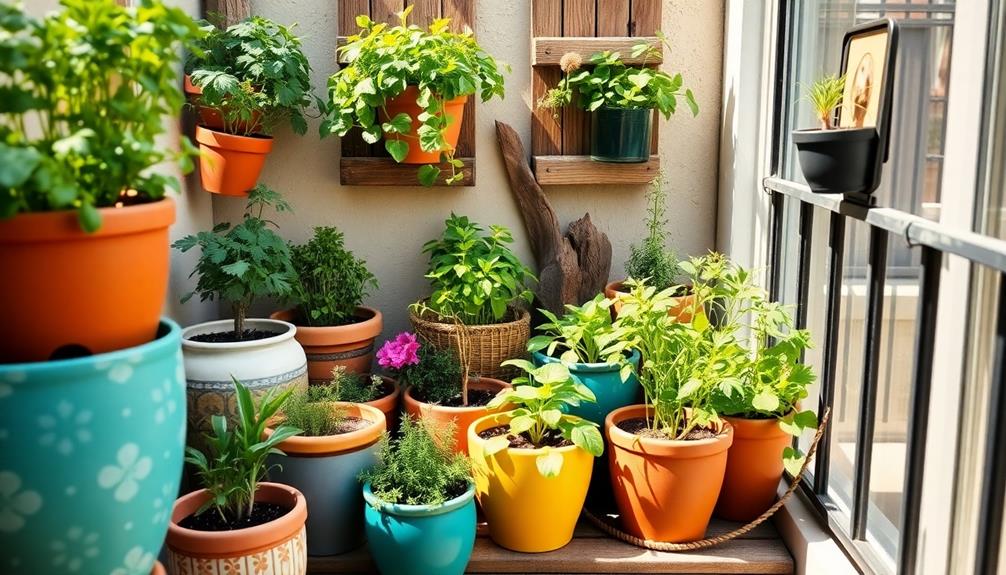
To set your boho herb garden up for success, it's crucial to choose the right containers and soil mix. Look for containers that are 6-12 inches deep, allowing enough space for shallow-rooted herbs. Guarantee proper drainage by including holes spaced every 3-4 inches.
For the soil, use a well-draining mix of topsoil, compost, and coarse sand, perfect for herbs from Mediterranean climates.
When planting your herbs, follow these techniques for best growth:
- Water Preferences: Place drought-resistant herbs like rosemary and thyme on the outer edges and moisture-loving ones like basil and parsley closer to the center.
- Spacing: Space your plants adequately to promote airflow, referring to the recommended spacing on plant tags. Fill any gaps with soil to support healthy root development.
- Watering: After planting, water thoroughly to settle the soil around the roots. Consider using organic fertilizers every few weeks to enhance growth.
With these planting techniques, your herbs will thrive beautifully on a sunny windowsill, giving you a vibrant and productive boho herb garden!
Creative Arrangement Ideas
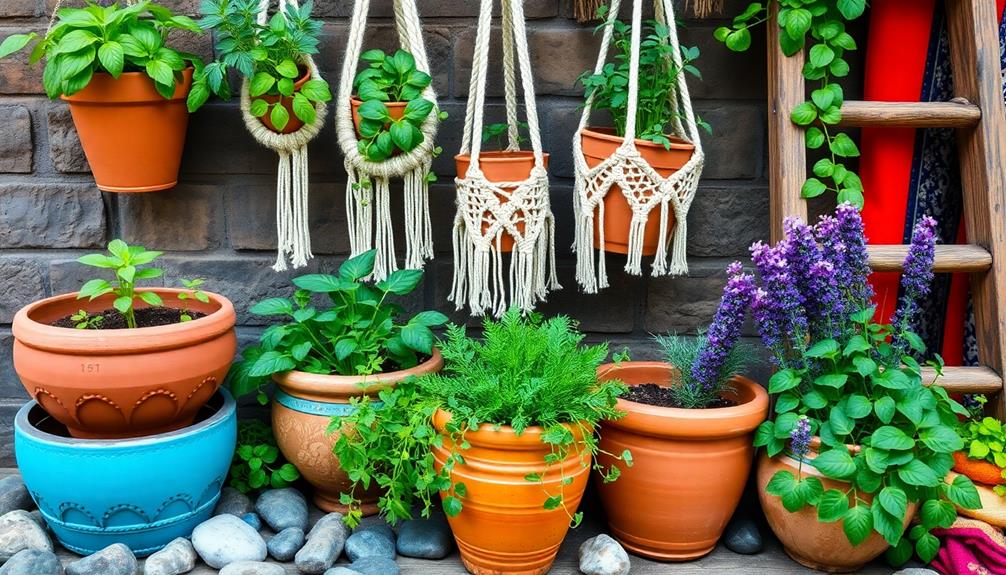
A boho herb garden thrives on creativity and individuality, so think outside the box when arranging your plants. One great method is to use a wooden window box and arrange your herbs in a zig-zag pattern. This not only maximizes space but also creates visual interest while ensuring each plant has room to grow.
For added sensory benefits, consider incorporating aromatic herbs like lavender and chamomile, which can also provide calming effects, similar to the benefits of aromatherapy for anxiety relief.
For added height and a fragrant touch, consider utilizing hanging baskets suspended from porch beams. This creates a lovely chandelier effect, making it easy to grab fresh cilantro and parsley.
You can also incorporate repurposed items like old teacups or painted tins as unique herb containers. This whimsical approach adds character and promotes creative reuse.
To save even more space, create a vertical herb garden using wall-mounted pockets or pallets. This method showcases diverse herbs like rosemary and thyme while enhancing the aesthetics of your small outdoor area.
Mixing various pot styles and colors will give your garden that playful boho vibe. Just be sure all containers have proper drainage and are filled with a well-draining soil mix to support healthy herb growth.
Embrace these creative arrangement ideas, and let your garden shine!
Maintenance Tips for Longevity
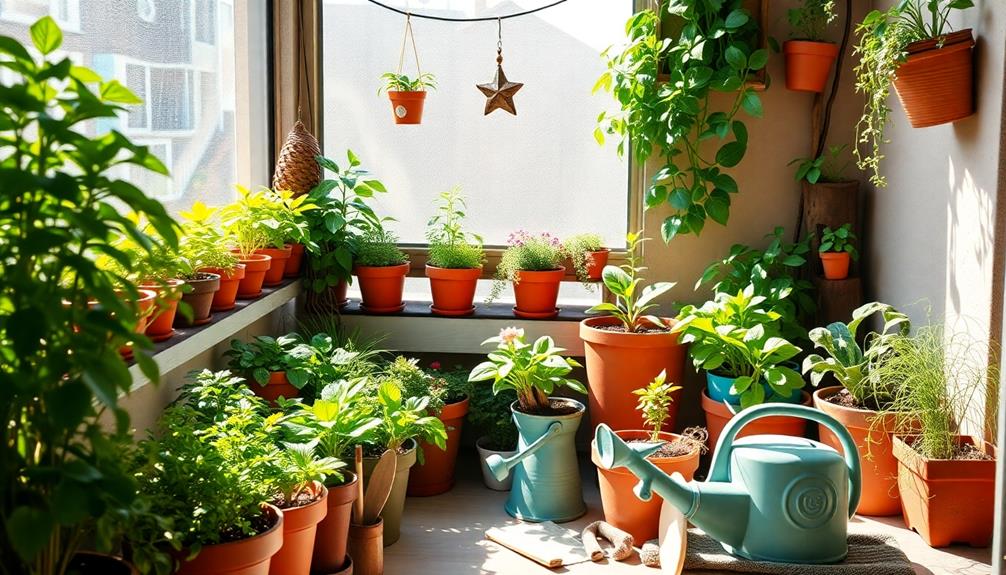
Creating a beautiful boho herb garden is just the beginning; maintaining it's key to guaranteeing it thrives for years to come. Follow these maintenance tips to keep your herb garden healthy and vibrant:
1. Monitor Soil Moisture: Regularly check the soil moisture to guarantee your herbs receive adequate water. Most herbs prefer well-draining soil that's kept slightly moist but not waterlogged.
Consider incorporating natural elements like plants and water features to enhance the overall atmosphere of your garden designing the perfect alfresco living space.
2. Fertilize Regularly: Use an organic slow-release fertilizer every 4-6 weeks. This provides essential nutrients without the risk of chemical buildup, promoting healthy growth in your herb garden.
3. Prune and Harvest: Frequently prune and harvest your herbs. This encourages bushier growth and prevents overcrowding, which can lead to disease and reduced air circulation around the plants.
Additionally, keep an eye out for pests and diseases by inspecting the leaves and stems regularly. Use organic treatments or insecticidal soap when necessary to maintain a healthy garden.
Incorporating Decorative Elements

Incorporating decorative elements into your boho herb garden adds personality and charm, transforming it into a vibrant oasis. Start by using vibrant, patterned textiles like macramé hangers or colorful cushions, which align with the modern farmhouse decor trends that emphasize natural materials and cozy aesthetics. These not only enhance your bohemian aesthetic but also provide comfort in your garden space.
Consider repurposing decorative items such as vintage teacups or painted tin cans as unique herb containers. This approach adds a personal touch while showcasing your creativity. Integrate natural elements like driftwood or stone accents to create a rustic charm, connecting your garden to nature and harmonizing with the boho theme.
Maximize your vertical space by utilizing hanging planters or wall-mounted frames adorned with artwork or mirrors. This adds visual interest and reflects the eclectic spirit of bohemian design.
To create a cozy ambiance, incorporate whimsical lighting features like string lights or lanterns. These elements make your herb garden a welcoming retreat for relaxation and culinary inspiration during the evenings.
With these decorative touches, your boho herb garden won't only flourish but also become a true reflection of your unique style and creativity.
Seasonal Care and Overwintering
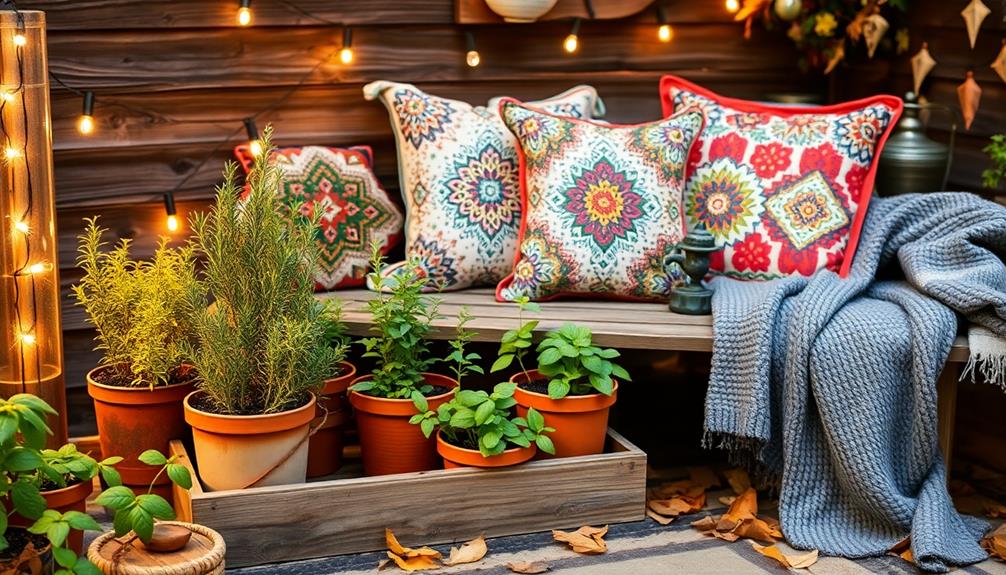
Overwintering your boho herb garden can be a rewarding experience, guaranteeing your plants thrive even during the colder months.
To successfully shift your herbs indoors, follow these key steps:
- Timing: Bring your potted plants inside before the first frost hits. This helps maintain their growth with adequate sunlight and warmth.
- Watering: Regularly check your indoor herbs for moisture. They typically need less water than when outdoors, so adjust your watering schedule to prevent overwatering and root rot.
- Light and Humidity: Provide supplemental light with grow lights to guarantee your herbs receive 12-14 hours of light daily. Also, consider using a humidity tray or misting to maintain appropriate humidity levels, especially for moisture-loving herbs like basil and mint.
Before moving your herbs inside, prune any dead or yellowing leaves. This encourages healthier growth and reduces pest risks during overwintering.
Frequently Asked Questions
How to Plan a Small Herb Garden?
To plan a small herb garden, assess your space and light conditions. Choose low-maintenance herbs, select appropriate containers, group them by water needs, and creatively utilize vertical space for maximum growth and aesthetic appeal.
How to Grow Herbs With Limited Space?
Growing herbs in limited space can feel challenging, but it's actually rewarding. Use shallow containers, group herbs by water needs, and think vertical. Prune regularly, and you'll enjoy fresh herbs right at your fingertips.
Which Herbs Should Not Be Planted Together?
You shouldn't plant mint with other herbs due to its aggressive growth. Basil and rosemary need different moisture levels, while cilantro and dill compete for resources. Finally, keep fennel away from most herbs to avoid inhibiting growth.
How Small Can an Herb Garden Be?
Your herb garden can thrive in containers as small as 6 inches deep. With proper sunlight and care, even shallow-rooted herbs like chives and basil will flourish, maximizing your small space's potential.
Conclusion
Creating a boho herb garden in small spaces brings a splash of nature right to your doorstep. Remember, "good things come in small packages." With the right containers, a thoughtful selection of herbs, and a touch of creativity, you can cultivate a vibrant oasis that's both functional and beautiful. Keep up with maintenance, add personal decorative touches, and your garden will thrive season after season. Enjoy the journey of growing your little green paradise!

